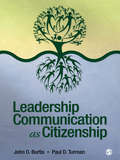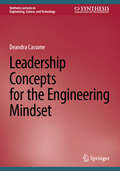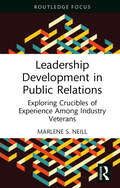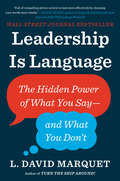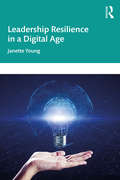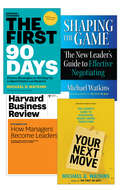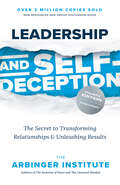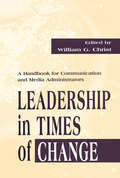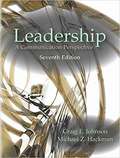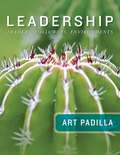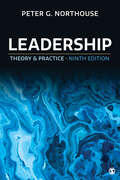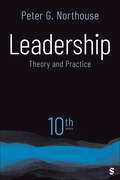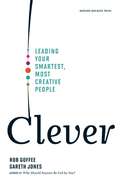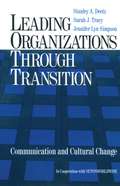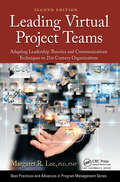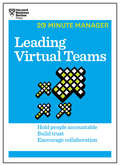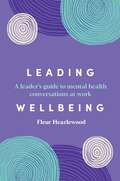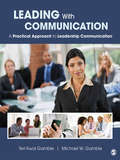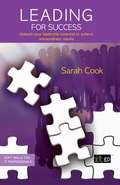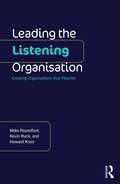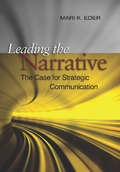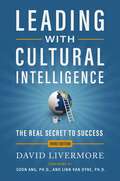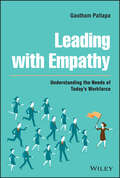- Table View
- List View
Leadership Communication as Citizenship
by John O. Burtis Paul David TurmanLeadership Communication as Citizenship explains the communication skills you need to help construct effective experiences for an organization, team, or community, whether in the role of doer, follower, guide, manager, or leader. It articulates the important role that communication plays in helping to co-construct group, organizational, or community direction. Effective leadership communication is explored in the context of citizenship, emphasizing the opportunities and responsibilities we each face for helping groups that matter to us, whether a business, a religious institution, or a government entity.Throughout the book, authors John O. Burtis and Paul D. Turman relay a compelling, readable story about how to create more successful organizations and communities through direction-giving stories, regardless of one′s role in the group.Key FeaturesExplains the daily interplay between communication, citizenship, and direction-giving, thus challenging readers to realize the power they have to give direction in their own team, organization, or communityFocuses on common communication skills involved across seemingly disparate leadership contexts—from working in teams to communities to social movements or elsewhere—to help people succeed in the setting in which they find themselvesExplores times of crisis and use of leadership vision, discussing how direction-giving approaches may require adjustment in these times of extreme opportunity, threat, or change.Intended Audience: Leadership Communication as Citizenship is appropriate for anyone who wants to make a difference in their team, organization, or community, and for such courses as Leadership, Organizational and Group Communication, Industrial/ Organizational Psychology, Persuasion, and Management.
Leadership Concepts for the Engineering Mindset (Synthesis Lectures on Engineering, Science, and Technology)
by Deandra CassoneThe book is intended to focus the engineer or technically minded individual on key aspects of their organization and how they can leverage their position to make a positive impact. The author explains why it is critical that the technically minded individual is aware of their corporate environment and how they and their organization fit within the organizational structure. Technical knowledge is just one component of success for engineers. The book provides readers with the tools to understand where they fit in with their organizations and what they can do to support corporate objectives. This book will address topics including gaining a big picture of an organization, defining what a specific organization does, understanding goals and objectives to align management strategies, budgeting, role in the supply chain, engineering career paths, and the importance of innovation.
Leadership Development in Public Relations: Exploring Crucibles of Experience Among Industry Veterans (Routledge Research in Public Relations)
by Marlene S. NeillThrough interviews with members of the Public Relations Society of America College of Fellows, this book provides lessons on public relations leadership for the next generation.Often, our focus on high profile leaders is centered on success stories, but so much can be learned from the trials, or “crucibles,” they have faced and how leaders overcame and were shaped by these challenges. The Fellows interviewed represent a diverse group of accomplished professionals with specializations ranging from military public affairs and government, corporate, education, agency, and nonprofit organizations. A focus on ethical values, virtues, and ethical leadership will inspire readers to themselves confidently lead.This book will be of interest to advanced students in public relations programs or young professionals looking to forge their careers in public relations leadership.
Leadership Is Language: The Hidden Power of What You Say--and What You Don't
by L. David MarquetFrom the acclaimed author of Turn the Ship Around!, former US Navy Captain David Marquet, comes a radical new playbook for empowering your team to make better decisions and take greater ownership.You might imagine that an effective leader is someone who makes quick, intelligent decisions, gives inspiring speeches, and issues clear orders to their team so they can execute a plan to achieve your organization's goals. Unfortunately, David Marquet argues, that's an outdated model of leadership that just doesn't work anymore.As a leader in today's networked, information-dense business climate, you don't have full visibility into your organization or the ground reality of your operating environment. In order to harness the eyes, ears, and minds of your people, you need to foster a climate of collaborative experimentation that encourages people to speak up when they notice problems and work together to identify and test solutions. Too many leaders fall in love with the sound of their own voice, and wind up dictating plans and digging in their heels when problems begin to emerge. Even when you want to be a more collaborative leader, you can undermine your own efforts by defaulting to command-and-control language we've inherited from the industrial era.It's time to ditch the industrial age playbook of leadership. In Leadership is Language, you'll learn how choosing your words can dramatically improve decision-making and execution on your team. Marquet outlines six plays for all leaders, anchored in how you use language: • Control the clock, don't obey the clock: Pre-plan decision points and give your people the tools they need to hit pause on a plan of action if they notice something wrong. • Collaborate, don't coerce: As the leader, you should be the last one to offer your opinion. Rather than locking your team into binary responses ("Is this a good plan?"), allow them to answer on a scale ("How confident are you about this plan?") • Commit, don't comply: Rather than expect your team to comply with specific directions, explain your overall goals, and get their commitment to achieving it one piece at a time. • Complete, not continue: If every day feels like a repetition of the last, you're doing something wrong. Articulate concrete plans with a start and end date to align your team. • Improve, don't prove: Ask your people to improve on plans and processes, rather than prove that they can meet fixed goals or deadlines. You'll face fewer cut corners and better long-term results. • Connect, don't conform: Flatten hierarchies in your organization and connect with your people to encourage them to contribute to decision-making.In his last book, Turn the Ship Around!, Marquet told the incredible story of abandoning command-and-control leadership on his submarine and empowering his crew to turn the worst performing submarine to the best performer in the fleet. Now, with Leadership is Language he gives businesspeople the tools they need to achieve such transformational leadership in their organizations.
Leadership Resilience in a Digital Age
by Janette YoungThe book focusses on the challenges faced in the digital age, and the increasing demands for continuous change in an inter-connected digital world. The book presents stories about how leaders have faced significant challenges and pressure, and how they have used these experiences as catalysts to transform, flourish, and develop personal resilience. The book explores the digital journey, ethical issues, teamwork, styles of leadership, agile, collaboration, trust, culture, psychological safety, self-awareness, vulnerability, conversation, positivity, emotional intelligence, creativity, inner knowing and the dark side of leadership. Drawing on the experiences of leaders in the creative, digital and technology sectors in the UK, and using their voice throughout, has resulted in proposing several internal and external strategic solutions to help the reader become more personally resilient. The book explores the impact of continuous change within a digital age, presenting the facets necessary to become a Digital Sage in an increasingly chaotic world. With a focus on creativity, innovation and mind and body awareness the leader as a Digital Sage arises to encourage resilience in a digital age. The book does not assume prior knowledge of the field of resilience and is ideal for executive education courses, and for leaders and managers seeking personal and professional transformation.
Leadership Transitions: The Watkins Collection
by Michael D. WatkinsThis Harvard Business Review collection features the best in leadership transitions from celebrated author and advisor Michael D. Watkins. Watkins, who has worked for decades guiding senior leaders into new roles to help them and their organizations succeed, is the author of the international bestseller The First 90 Days. With more than 400,000 copies sold worldwide and published in more than 25 languages, the book has become the standard reference for leaders in transition.In addition to the full digital edition (ebook) of The First 90 Days, this collection includes digital editions of Watkins' other popular works: Your Next Move, which guides professionals through the most common career transitions; Shaping the Game, on how to lead effective negotiations; and his 2012 Harvard Business Review article, "How Managers Become Leaders."Watkins, whose ideas have guided some of the world's best leaders through successful transitions, is the chairman of leadership development consultancy Genesis Advisers. Drawing on the perfect combination of research and hands-on experience, he has spent the last two decades working with leaders-both corporate and public-as they transition to new roles, negotiate the future of their organizations, and craft their legacy as leaders. He was previously a professor at the Kennedy School of Government at Harvard, Harvard Business School, INSEAD in France, and IMD in Switzerland.
Leadership and Self-Deception, Fourth Edition: The Secret to Transforming Relationships and Unleashing Results
by The Arbinger InstituteWith almost 3 million copies sold worldwide, this new edition of an enduring classic is the definitive guide to dramatically improve leadership effectiveness, transform personal and professional relationships, and unleash organizational results. Significantly revised throughout, this edition includes updated stories, brand new content, and a practical group discussion guide.Over two decades since first being published, Leadership and Self-Deception continues to help readers discover and overcome the persistent lies that are at the heart of the people-related dysfunction that plagues relationships and hinders organizational results. Told through an engaging story, this book reveals the ways we blind ourselves to our true motivations and unwittingly sabotage our efforts to achieve success and rebuild broken relationships. Completely rewritten throughout, this fourth edition features important updates: A broader cast of characters who resonate with a wide and diverse audience Updated stories and examples that help readers immediately apply these timeless concepts to the modern workplace An individual study and group discussion guide to facilitate personal and team discoveries Practical guides to apply the tools on a personal, team, and organization-wide levelExplore the ideas that have helped millions of people and thousands of organizations sustainably transform relationships and results.
Leadership in Times of Change: A Handbook for Communication and Media Administrators (Routledge Communication Series)
by William G. ChristThis book addresses many of the issues facing new and seasoned communication and media administrators. Though there are business-oriented management and leadership books, there is no handbook--to the editor's knowledge--that emphasizes academic administration. This book fills an important gap in the literature by providing--in one place--interesting, important, and useful information that will help administrators by anticipating problems and suggesting strategies for the variety of challenges they face. This scholarly, anecdotal, useful, and very readable volume is conceived as an action handbook that contains philosophical, theoretical, and practical information. It is divided into three sections: background material, programmatic challenges facing administrators, and specific challenges facing administrators. It contains information that both the seasoned administrator and those faculty who are thinking about moving into administration will find useful. Although aimed at the communication and media disciplines, administrators in other fields will also find it valuable. In addition, deans and vice presidents outside the discipline who are responsible for communication and media programs will view the book a "must" read.
Leadership: A Communication Perspective
by Michael Z. Hackman Craig E. JohnsonLeadership: A Communication Perspective has been at the forefront of university and college leadership courses for nearly three decades, providing a compelling, authoritative introduction to leadership as a communication-based activity. The new edition continues the tradition of excellence with an up-to-date treatment of theory and research combined with practical, real-world advice for improving communication competence and leadership effectiveness. The authors profile contemporary leaders and organizations like Alibaba's Jack Ma, Zappos' Tony Hsieh, Facebook's Sheryl Sandberg, Uber, The Container Store, Airbnb, Chipotle, the Waffle House, Nordstrom, and Google. Their presentation balances current scholarship and trends with historical perspectives to provide a fuller understanding of the study and practice of leadership. <p><p> Leadership and followership are examined in multiple contexts, including organizational leadership, public leadership, and leadership in groups and teams. Topics new to this edition include transcendent followership, the leadership skills approach, team coaching, escalation of commitment, invisible leadership, cultural intelligence, trigger events, and resilience.
Leadership: Leaders, Followers, and Environments
by Arthur PadillaLeadership is a “process,” not a person. In Leadership, author Art Padilla asserts that the dynamics of leadership involve leaders, followers and their environments—the organizational contexts within which leading and following take place. This triangle approach illustrates a more holistic and comprehensive view of leadership by focusing on all three dynamics.While infused with the most contemporary research and latest theories, material comes to life through chapter inserts and mini cases featuring themes that leaders and followers regularly encounter, such as: mentoring and developing talent, ethics, integrity and credibility, teams, and toxic leadership.Using the most current examples to demonstrate concepts, the author encourages students to perceive instances of leadership, and the leaders, followers and environments that make them relevant.
Leadership: Theory and Practice
by Peter G. NorthouseAdopted at more than 1,600 institutions in 89 countries and translated into 15 different languages! The market-leading Leadership: Theory and Practice by Peter G. Northouse presents an academically robust account of the major theories and models of leadership with a focus on how theory can inform practice. Northouse uses a consistent structure for each chapter that allows readers to easily compare and contrast different theories. Case studies and questionnaires provide students with practical examples and opportunities to deepen their understanding of their own leadership style. The fully updated Ninth Edition features a new chapter on inclusive leadership, 17 new real-world cases that profile leaders from across the globe, a new discussion on leadership and morality, and examples of timely issues such as leadership during the COVID-19 pandemic. This title is accompanied by a complete teaching and learning package.
Leadership: Theory and Practice
by Peter G. NorthouseAdopted at more than 1,600 institutions in 89 countries and translated into 15 different languages! The market-leading Leadership: Theory and Practice by Peter G. Northouse presents an academically robust account of the major theories and models of leadership with a focus on how theory can inform practice. Northouse uses a consistent structure for each chapter that allows readers to easily compare and contrast different theories. Case studies and questionnaires provide students with practical examples and opportunities to deepen their understanding of their own leadership style. The fully updated Ninth Edition features a new chapter on inclusive leadership, 17 new real-world cases that profile leaders from across the globe, a new discussion on leadership and morality, and examples of timely issues such as leadership during the COVID-19 pandemic. This title is accompanied by a complete teaching and learning package.
Leadership: Theory and Practice
by Peter G. NorthouseNow with a new chapter on Social Identity Leadership! Adopted in thousands of courses in 89 countries and translated into 15 different languages, this market-leading text successfully combines an academically robust account of the major theories and models of leadership with an accessible style and focus on how leadership theory can inform leadership practice. Peter G. Northouse uses a consistent structure for each chapter, allowing readers to easily compare and contrast different theories. Case studies and questionnaires provide students with practical examples and opportunities to deepen their understanding of their own leadership style.
Leadership: Theory and Practice
by Peter G. NorthouseNow with a new chapter on Social Identity Leadership! Adopted in thousands of courses in 89 countries and translated into 15 different languages, this market-leading text successfully combines an academically robust account of the major theories and models of leadership with an accessible style and focus on how leadership theory can inform leadership practice. Peter G. Northouse uses a consistent structure for each chapter, allowing readers to easily compare and contrast different theories. Case studies and questionnaires provide students with practical examples and opportunities to deepen their understanding of their own leadership style.
Leading Organizations through Transition: Communication and Cultural Change
by Stanley A. Deetz Dr Sarah J. Tracy Ms Jennifer Lyn SimpsonThis book addresses the role of communication in cultural change efforts within organizations, especially during periods of transition, mergers, technological innovations and globalization.
Leading Virtual Project Teams: Adapting Leadership Theories and Communications Techniques to 21st Century Organizations (Best Practices in Portfolio, Program, and Project Management #5)
by Margaret R. LeeThe second decade of the 21st century has brought unprecedented challenges to traditional workplaces. The global pandemic has forced the advance of working from home and telework. Individuals with little or no background or training in e-leadership, virtual project management, or virtual team management suddenly found themselves in the environment of virtual work. Leading Virtual Project Teams, Second Edition addresses the challenges that today’s virtual project management environment poses to traditional methods of leadership and communication. Leadership for successful virtual team management is different from that for traditional, collocated project team management. Explaining appropriate e-leadership styles for virtual project teams and the transition toward new leadership styles, the book is filled with communication techniques for leading virtual project teams. It helps project managers develop e-leadership competencies needed to successfully deliver projects in today’s organizations. The second edition also examines: Virtual meeting techniques Inclusive language Managing virtual relationships Why virtual work is now more important The work-at-home environment By recognizing how virtual teams are different from traditional teams, those managing virtual projects may be able to offer benefits to their organization by providing positive, successful leadership and exceptional communications, resulting in better project deliverables and products. This book provides an approach that explores all facets of e-leadership—from how traditional leadership theories and models can be applied by 21st century leaders to providing methods by which the virtual project manager can enhance virtual project communications to meet the needs of our modern global business world. It features project management checklists and templates and includes business cases, best practices, and tools and techniques for virtual project management communications.
Leading Virtual Teams (HBR 20-Minute Manager Series)
by Harvard Business ReviewLeading any team involves managing people, technical oversight, and project administration, but leaders of virtual teams perform these functions from afar. Leading Virtual Teams walks you through the basics of: Connecting your people to each other-and to the team's mission Surmounting language, distance, and technology barriers Identifying and using the right communication channelsDon't have much time? Get up to speed fast on the most essential business skills with HBR's 20-Minute Manager series. Whether you need a crash course or a brief refresher, each book in the series is a concise, practical primer that will help you brush up on a key management topic. Advice you can quickly read and apply, for ambitious professionals and aspiring executives-from the most trusted source in business. Also available as an ebook.
Leading Wellbeing: A Leader's Guide to Mental Health Conversations at Work
by Fleur HeazlewoodLeaders have the responsibility to provide a psychologically safe and well work environment for their teams. With levels of stress and burnout rising, and one in five people experiencing mental illness, mental health conversation skills are no longer a nice-to-have. Mental health conversation competence is a necessary part of our leadership toolkit.Our leaders also juggle the daily pressure of competing priorities, urgent deadlines and overwhelming workloads while worrying about their team' s wellbeing, and are at risk of developing chronic stress and burnout themselves.Many leaders feel ill-equipped, lacking the skills and training to have the difficult and supportive mental health conversations that are needed to support the wellbeing of their people. Leading Wellbeing addresses the key concerns for leaders and presents a clear framework to follow for recognising the signs someone is struggling, providing psychological safety, what to say, what support is appropriate and how to balance both care and performance needs.The Mental Health Mastery approach improves leader confidence, capability and capacity in having the necessary, difficult conversations at work.
Leading With Communication: A Practical Approach to Leadership Communication
by Teri Kwal Gamble Michael W. GambleLeading with Communication, by bestselling authors Teri and Michael Gamble, prepares today's students to acquire skills, develop a global perspective, and master the technology they need to enhance their visibility and credibility as leaders. Addressing leadership from the students' perspective, the book facilitates in readers the ability to nurture their leadership and team-building talents. The book's emphasis on skills, including its focus on developing the global and technological competencies that support the performance of leadership, promotes in students the ability to think critically and imaginatively. With this text, students will learn to communicate effectively as they also learn how to inspire confidence, foster innovation, and build an effective team.
Leading for Success
by Sarah Cook"Leading for Success" is designed to assist IT managers in understanding the characteristics of an effective leader, to help them assess where their strengths and development areas are, and to create a plan of action for realizing their leadership potential.
Leading the Listening Organisation: Creating Organisations that Flourish
by Kevin Ruck Mike Pounsford Howard KraisHow organisations listen, learn, and adapt to their environment drives success and long-term sustainability. This book focuses on internal stakeholders and how employers can use the voice of their people to improve decision-making, innovation, and performance. It is about why listening to employees matters and how to do it well. Leading the Listening Organisation reveals not just the practices and processes that underpin effective listening but also the leadership characteristics and mindsets necessary to create resilient organisations that feel fair to work in, where people want to speak up, and where new ideas can flourish. It is based on extensive international research with leaders across over 500 organisations before, during, and after the pandemic. The authors bring decades of international experience and expertise in communicating with employees across public, private, and third sector organisations. Rich in practical tools, processes, and working frameworks and brought to life with case studies and insights from leaders and communicators, this book provides a complete guide to understanding the barriers to, and implementation plans for, leading a listening organisation. This comprehensive guide will resonate with leadership, internal communications, human resources, and organisational development professionals.
Leading the Narrative
by Mari K. EderThe Strategy of Communication is a primer on the art and science of strategic communication. This book covers the foundation of communications strategies as well as solid tactics, techniques, and procedures for media relations, campaign planning, crisis communication and strategic communications planning. It is both a philosophy of communication and a solid practical reference manual. Like no other book on public relations, public diplomacy, or media operations and community outreach, it offers a compelling look at how all communication processes can be made to function more efficiently and with greater effectiveness. The ties are those of intention and purpose, both leading to meaningful and purpose-driven communication efforts, whether conducted by governments, organizations, or military units.From the most basic precepts of media relations interaction to massive information campaigns directed from the seat of government, communication that is broad-based, overarching and tied to strategic objectives can ultimately succeed using a variety of methods, from storytelling to building external champions. Practitioners and news media representatives alike should be aware of the nature of repetitive patterns in events, the power of myth in storytelling, and the significance of self-fulfilling prophesies. Influencing factors include new technologies that flatten communication hierarchies, social media platforms that empower amateurs, generational divides and a general decline in respect for the journalism profession and ebbing trust in the news as reported by the mainstream media. A coarsening of the public discourse throughout our celebrity-saturated culture likewise contributes to the difficulty of communicating with resonance and result in a toxic information environment. This book, a collection of collected essays on the communication practice, represents both a deeply passionate, strategically reasoned and thoroughly researched commentary on the field. It is both practical and theoretical.
Leading with Cultural Intelligence 3rd Edition: The Real Secret to Success
by David LivermoreAs our workplaces become increasingly global and diverse, being a culturally intelligent leader isn't just a bonus—it's essential.Whether you're negotiating a contract with a supplier on the other side of the world, managing an increasingly diverse workforce, expanding your business across borders, or developing and applying cultural intelligence (CQ), this classic resource provides you with the adaptability you need to motivate, negotiate, and accomplish results with anyone, anywhere.Having done consulting and research with leaders in more than 100 countries, David Livermore, founder of the Cultural Intelligence Center and professor at Boston University, has detailed the four CQ skills that are proven to maximize your leadership success in today&’s diverse, global business environment:Drive—build your motivation and confidence to address cultural dilemmasKnowledge—learn how to read any cultural situationStrategy—create an inclusive, agile plan that accounts for diverse stakeholdersAction—adapt your leadership style without compromising effectiveness Featuring the latest research, case studies, and new chapters on how to lead culturally intelligent organizations and teams, this new edition of Leading with Cultural Intelligence will help you thrive in any leadership environment—whether it's across the world or in your own back yard.
Leading with Empathy: Understanding the Needs of Today's Workforce
by Gautham PallapaLearn to lead others through adversity with the power of human connection. In Leading with Empathy: Understanding the Needs of Today’s Workforce, acclaimed strategist and business leader Dr. Gautham Pallapa presents an insightful roadmap to leading people through adversity and empowering humans in the workplace, the home, and society. Through this book, the distinguished author examines the impact of recent world-shaking events and how they have impacted us as a species and as individuals. He explores how empathy can help alleviate some of the more harmful effects of hardship and offers key actions that empathic leaders can take to inspire their followers. Finally, the book describes how to transform the way we work by rethinking and reimagining existing processes and innovatively introducing strategic disruption. Leading with Empathy also includes: Stories, anecdotes, and personal musings that grant visibility and validation to the suffering of others Exercises and strategies to reduce stress, anxiety, and improve happiness and positivity Actions that enable leaders to empower people through empathy, collaboration, and communication. An essential read for executives, managers, and business leaders of all types, Leading with Empathy will also earn a place on the bookshelves of military, athletic, and educational leaders who seek to inspire their followers and empower humanity in the face of adversity.
